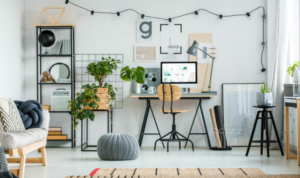In recent times, the concept of working from home has become a prevalent and necessary practice for many professionals. As remote work continues to be the norm, the importance of having a well-designed and productive home office has become increasingly evident. A thoughtfully designed home office not only enhances productivity but also contributes to improved focus, efficiency, and overall well-being. In this article, we will explore various strategies to create a productive remote work environment by carefully selecting home office furniture and incorporating creative design ideas.

Contents
Assessing Your Space and Needs
Before diving into furniture selection and design, the first step is to assess your available space and work requirements. Consider the following factors:
Choose the Right Location
Select a quiet, well-lit, and dedicated area in your home that allows you to work without distractions. A separate room or a corner of a room away from high-traffic areas is ideal.
Evaluate Your Work Tasks
Identify the specific tools and equipment you’ll need for your job. This may include a computer or laptop, printer, office supplies, and storage solutions for documents and files.
Ergonomic Office Furniture
Ergonomics is a critical aspect of a productive home office. Investing in ergonomic office furniture helps maintain comfort, prevents strain, and promotes better posture. Consider the following furniture options:
Ergonomic Chair
Choose a chair that offers proper lumbar support, adjustable height, and comfortable padding to ensure optimal posture and reduce the risk of back pain.
Height-Adjustable Desk
Opt for a desk that allows you to adjust its height, allowing you to switch between sitting and standing throughout the day. This promotes better blood circulation and reduces fatigue.
Prioritizing Functionality and Organization
An organized workspace contributes to increased productivity and efficiency. Consider incorporating the following organizational elements:
Ample Storage Solutions
Install shelves, cabinets, or filing cabinets to keep your documents, office supplies, and equipment well-organized and easily accessible.
Cable Management
Keep cables and cords organized and out of the way to avoid tangling and tripping hazards. Invest in cable management solutions to maintain a tidy and visually appealing workspace.
Incorporating Inspirational Design
Creating an aesthetically pleasing and inspiring home office environment can significantly impact your mood and motivation. Consider the following design elements:
Colours
Choose a colour scheme that promotes focus and positivity. Blue and green are often associated with tranquillity and concentration, while yellow can evoke creativity.
Personal Touch
Add decor, artwork, or plants that reflect your personality and create a welcoming atmosphere. Personalizing your workspace can increase comfort and job satisfaction.
Lighting Matters
Proper lighting is essential for reducing eye strain and maintaining focus during long work hours. Consider the following lighting options:
Natural Light
Natural light not only boosts mood but also helps regulate your circadian rhythm.
Task Lighting
Invest in a desk lamp with adjustable brightness to provide ample lighting for specific tasks. Proper task lighting can prevent eye fatigue and improve productivity.
Noise Reduction
A quiet and peaceful workspace is vital for concentration and uninterrupted workflow. Consider the following noise reduction techniques:
Soundproofing
If your home office is susceptible to external noise, consider installing noise-absorbing panels or using soundproof curtains to minimize distractions.
White Noise
Use white noise machines or apps to mask background sounds and create a consistent ambient sound that helps you focus.
Conclusion
In conclusion, creating a productive home office requires careful planning, thoughtful furniture selection, and creative design ideas. By assessing your space and needs, investing in ergonomic furniture, staying organized, and incorporating inspirational design elements, you can design a home office that fosters productivity, creativity, and overall well-being during remote work. Remember, a well-designed home office enhances your professional performance and overall quality of life as you embrace the benefits of remote work.
